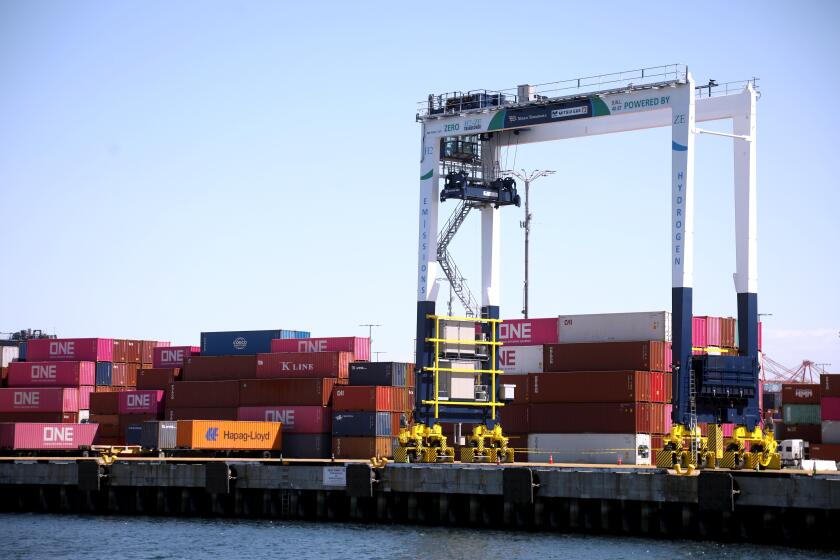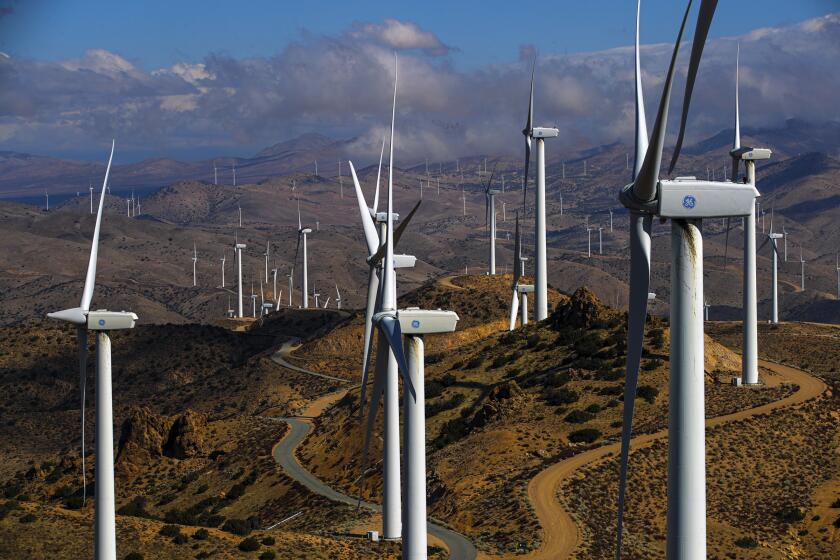
- Share via
- President Trump has made specific threats to California’s environmental efforts, including its vehicle emission standards and cap-and-trade program.
- Experts say the state has the tools, means and desire to to fight back through lawsuits and legislation.
Less than six months into his second term as president, Donald Trump has initiated or proposed more than 150 actions that experts say are detrimental to the environment, which range from cancelling climate grant programs to loosening regulations that govern air and water quality.
Many of these actions have been part of the president’s larger goals of reining in government spending, increasing energy independence and restructuring federal agencies. But some also appear to target one state in particular: California.
‘These State laws and policies are fundamentally irreconcilable with my Administration’s objective to unleash American energy,’ the president wrote. ‘They should not stand.’
Long known as a nationwide leader in climate and environmental policy, the Golden State has been in Trump’s crosshairs since his first administration, when he sparred with Gov. Gavin Newsom over issues such as forest and water-supply management. In recent months, Trump has escalated his California-specific efforts, including vowing to block the state’s ability to set strict tailpipe emission standards — a battle that has wound all the way up to the Senate.
Many of the president’s actions in the first 100 or so days of this administration have not only called out California by name, but also disproportionately targeted it. A leaked list of pending program cuts from the Department of Energy includes 53 projects in California — more than any other state — as well as more projects in blue states than red ones.
In April, the president named California in an executive order directing the Department of Justice to seek out and “stop the enforcement of” state laws that address climate change, in which he described California’s first-of-its-kind cap-and-trade program as an unfair means of punishing businesses for their use of fossil fuels.

Experts say it’s not surprising that the president is coming for California’s environmental progress. Trump received record donations from oil and gas companies during his campaign. Meanwhile, California, a Democratic stronghold, has set aggressive climate targets that seek to limit those industries and transition the state to carbon neutrality by 2045.
“One hundred percent, California is targeted,” said Mary Creasman, chief executive of the nonprofit California Environmental Voters. “It’s along the same lines as everything we have seen from this president: political retaliation at every turn toward anybody who disagrees with him on anything — and California disagrees with him on a lot.”
A major national effort to develop clean hydrogen energy is facing funding cuts — but only in Democratic states.
But California also has the tools, means and motivation to to fight back, Creasman and others said, including through litigation and legislation.
Already, the state has filed or joined nearly 50 legal actions against the current administration, at least seven of which pertain to the environment.
Among them is a lawsuit challenging the president’s declaration of a national energy emergency, which calls for for increased fossil fuel production, waived environmental reviews and the fast-tracking of projects in potentially sensitive ecosystems and habitats.
“These procedures misuse authorities meant for disaster response and bypass important health and environmental protections for the benefit of the fossil fuel industry,” California Atty. Gen. Rob Bonta wrote in a statement about that case.
Bonta has also joined a lawsuit against the administration’s plans to freeze federal funding for a number of programs that Trump has disparaged as “woke,” including environmental measures. Other suits challenge attempts to claw back funding for the construction of electric vehicle charging stations across the country; wind energy development; and the AmeriCorps program that deploys young people to disaster-relief organizations.
The California attorney general has also joined a motion to defend the Environmental Protection Agency’s chemical-accident safety rules from state and federal efforts to weaken or repeal it, and has signed onto an amicus brief opposing mass federal layoffs at agencies such as the EPA and the Federal Emergency Management Agency.
State lawmakers — including Sens. Adam Schiff and Alex Padilla — have thrown their hats in the ring as well, penning letters to the heads of various agencies in opposition to climate grant cuts at the EPA, the closure of the federal disaster tracking system and other issues.
President Trump’s administration, with help from the Republican-led Congress, may pull the state’s ability to set its own fuel-efficiency rules.
Such challenges are a critical line of defense for California and other states working to preserve climate progress, said Pete Maysmith, president of the League of Conservation Voters, a D.C.-based nonprofit advocacy group.
“We have to litigate, we have to organize, we have to win elections,” Maysmith said. “We need our champs in Congress — many of whom call California home — to stand up and fight against things like trying to revoke the clean air waiver that California has had for 50 years.”
Indeed, the battle over clean air waivers is among the state’s most ferocious fights so far.
For decades, California has been granted special authority to set its own vehicle-emission standards by utilizing waivers issued by the EPA. Clean Air Act waivers have been fundamental to the state’s efforts to limit greenhouse gases and transition to electric vehicles, such as its ban on the sale of new gas-powered cars by 2035.
But Trump has moved to block the state’s authority to do so, and earlier this month, the U.S. House of Representatives agreed with him. Now the battle is set for a vote in the Senate, which could happen as soon as this week.
Cliff Rechtschaffen, a member of the California Air Resources Board, believes the president is targeting the state in part because of its special authority.
“I think California stands out because we are the leader on so many things, including our clean car and zero-emission vehicle standard,” Rechtschaffen said. Should California lose the Senate battle, the state will challenge it in the court system, he said.
California can achieve a similar outcome without the waivers, Rechtschaffen said, such as raising registration fees or imposing taxes on heavily polluting vehicles — a tactic deployed in Norway that resulted in nearly all new cars purchased there last year being electric vehicles.
California could also consider instituting a statewide “indirect source” rule that would require ports and other facilities to limit pollution in the surrounding area, which could, for example, compel trucking companies using those ports to deploy low- or no-emissions vehicles.
The House took a trio of votes this week targeting California’s decades-old authority to enforce its own environmental standards, setting the stage for a significant standoff in the U.S. Senate.
While the Clean Air Act issue is complicated, other battles may be simpler. That includes Trump’s bid to halt the state’s cap-and-trade program, which sets limits on companies’ greenhouse gas emissions and allows them to sell “credits” for unused emissions to other companies.
Experts say he does not actually have the authority to end California’s program.
“It’s not really something that Trump or the attorney general can do. If you want to stop the enforcement of state law, you have to go to court, and that’s the jurisdiction of the court,” Maggie Coulter, a senior attorney with the Climate Law Institute at the nonprofit Center for Biological Diversity, said about the executive order.
Rechtschaffen agreed, noting that the state does not need federal authority to maintain a cap-and-trade program. Neither the EPA nor Congress has created a national cap-and-trade program that preempts state programs, “so it’s completely lawful under state law, and I don’t see anything under current federal law that would threaten our program,” he said.
The California Air Resources Board has released its long-awaited scoping plan, a roadmap for the state to drastically cut its carbon emissions.
Beyond defending itself in the courtroom, California can also use legislation to go on the offensive, according to Creasman, of California Environmental Voters.
The state is already flexing its legislative strength with two 2023 laws slated to go into effect next year. Senate Bills 253 and 261 will require large corporations that do business in California to measure and publicly disclose their carbon emissions. Creasman said the laws leverage California’s market size to help push national policy, and could be a model for similar efforts in the future.
Another law winding through the state legislature, Senate Bill 684 — known as the “Polluters Pay Climate Superfund Act” — would require fossil fuel polluters to pay for their share of damages and disasters caused by their emissions. The funds would be put toward projects and programs to prepare for and respond to climate change.
“As we see the federal government starting to shrink resources, ‘Polluters Pay’ is a really important mechanism,” Creasman said.
Should the federal government succeed at rolling back protections under the Clean Air Act, Clean Water Act, Endangered Species Act and other rules, California could also consider a concept known as “trigger laws” to restore state standards set under the previous administration, Creasman said.
Trigger laws become enforceable only by specific events or conditions. One recent prominent example was when several states used the laws to trigger immediate abortion bans in the wake of the Supreme Court overturning Roe vs. Wade.
This combination of weapons in California’s arsenal — litigation, legislation and a large economy — mean California can mount a good defense when it comes to the environment, Creasman added.
“It is dangerous to not approach this moment with the gravity and reality of what we’re in — and what we’re in is a fight for our lives,” she said.
Times staff writer Kevin Rector contributed to this report.












